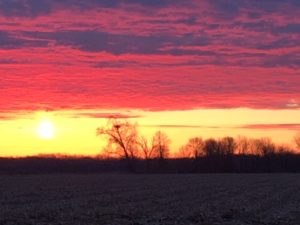 Dimming my headlights, I turn onto the gravel lane and let the car roll slowly downhill in the direction of the Crawfish River. Ostensibly, I am here to count sandhill cranes, but the first order of pre-dawn business is to look – and listen – for snipe.
Dimming my headlights, I turn onto the gravel lane and let the car roll slowly downhill in the direction of the Crawfish River. Ostensibly, I am here to count sandhill cranes, but the first order of pre-dawn business is to look – and listen – for snipe.
I lower my window, turn off the car and close my eyes. And there it is: an eerie whir that rises and fades, rises and fades as air rushes over the fanned tail feathers of a Wilson’s snipe in territorial display. Through my binoculars I search the twilit sky and finally make out the ghostly form of the foot-long shorebird in its quick, stuttering flight.
Next, I scan the treetops and spy the silhouette of a great-horned owl keeping watch over Faville Grove. Since 2011, this has been “my” survey block for the Midwest Crane Count, an annual tradition in six midwestern states for birders, citizen scientists, and people who simply like cranes. The Crane Count began in the 1970s as a tool to gather data for the International Crane Foundation on habitats used by sandhill cranes, and to get a better handle on population estimates. For volunteer surveyors, it’s not just a citizen science project, but a chance to deepen their connection to a place by visiting repeatedly and noting what has changed – and what stays the same – over time.
It’s still dark at 5:41, when I scrawl blindly in my notebook that the snipe has fallen silent; when I get home I’ll compare that time to last year’s notes. Now I sit quietly and tune in to the familiar dawn chorus, dominated by song sparrows, red-winged blackbirds, and the faint, rising song of horned larks.
Four minutes later, as if on cue, the deep-throated bugle of a male sandhill crane rises from the downstream bottomland, punctuated by a higher-pitched response from his mate. I jot, “Unison call – near river bend,” in my notes.
At 6:00, they call again, declaring to all who hear that they are a pair, and that that stretch of river is theirs. Soon, a second unison call comes from a territory to the north, and now the calls alternate in a sort of duel. I’ve heard such exchanges before, like a standoff between feuding neighbors: “Stay off my property,” one shouts. “Fine,” the other answers, “as long as you stay out of mine.”
All right, then. I record the second pair in my notes: Two pairs, both apparently nesting my survey block.
On the Jefferson County Crane Count map, this stretch of the Crawfish River, including Faville Grove, is simply called “Block 7,” but to me, it represents much more. It’s the place where I met my husband, and the place where I first witnessed the process by which farmland can be slowly restored to prairie. It’s a place that captured the imagination of Aldo Leopold and several of his graduate students.
And it’s becoming my personal rite of spring. I’m beginning to have a sense of what I’ll find here whey I pay a solitary visit before sunrise in mid-April: grasshopper sparrows, gobbling turkeys, mallards and blue-winged teal. Geese, of course. Bluebirds and tree swallows will be staking out nest boxes. And perhaps a northern harrier – yes, there she is, skimming low over the grasses with a male in pursuit.
As traditions go, mine is of short duration – scarcely a blip. But it’s a beginning, I think, as I gaze east toward the river. Sunrise paints the low, ragged clouds a gentle melon color that quickly warms to a fierce magenta.
Night becomes day. A pair of cranes flies overhead, trumpeting. The minutes tick past, and at 7:30 I write, “End” in my notes…until next year.

